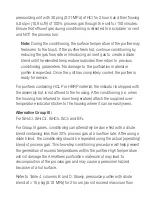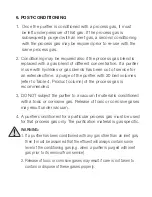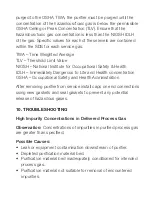
rate for conditioning – column D). Then flow dilute blend gas for the minimum
volume (column B) of process gas to flow through purifier and a flow rate
that is ≤ the maximum flow rate not to be exceeded during conditioning.
After completing the dilute blend conditioning, repeat with actual process gas
concentration for an additional 200 – 300 bed volumes (Product column). If
use of a dilute blend is not possible, use actual process gas concentration
at a reduced flow rate (10% of value in column D). As an example, condition
a Gaskleen
®
PG550 Purifier for SiH
2
Cl
2
service by first pressurizing unit with
10% SiH
2
Cl
2
blend for 2 hours. Follow this by flowing 1.0 slpm (2.1 scfh) of
10% SiH
2
Cl
2
blend through the unit for 3 hours. Then switch flow to 5 slpm
(10.6 scfh) of 100% SiH
2
Cl
2
process gas through the unit for an additional
33 minutes.
Ensure that effluent gas during conditioning is directed to a suitable scrubber
or vent and NOT to the process tool.
Note:
During conditioning of these Group III gases, the purifier may feel
warm to the touch. If the purifier feels hot, reduce the gas flow rate or use
a more dilute blend for conditioning.
Group IV:
For C
2
H
4
, C
3
H
6
, COS, SiH
4
, Si
2
H
6
, SiH
3
CH
3
, SiH(CH
3
)
3
, GeH
4
, SF
6
, and B
2
H
6
.
For Group IV gases, it is strongly recommended that conditioning be done
first with a dilute blend containing less than 20% process gas at a low flow
rate. After using a dilute blend, the conditioning should be repeated using
the actual (operating) blend of process gas. This two-step conditioning
procedure will help prevent the generation of excess temperatures within
the purifier. High temperature will not damage the AresKleen purification
material but may lead to decomposition of the process gas and may cause
a personnel hazard because of a hot surface.














































